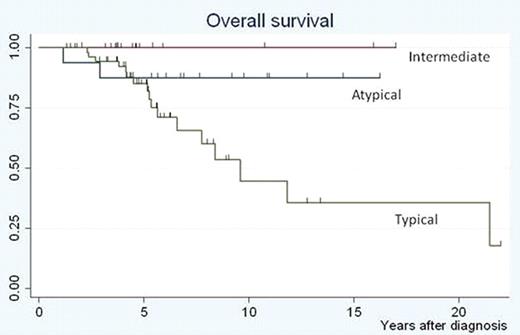Abstract
Abstract 4594
B-chronic lymphocytic leukemia (B-CLL) is rare in Japan. Therefore, only a few data are available on the clinical characteristics of B-CLL for Japanese patients (pts). We reported that the rate of atypical CLL appeared to be higher in Japanese pts than that of Caucasians.
This nation-wide study was performed from Oct. 2003 to March 2008, and was supported by Japanese Elderly Leukemia and Lymphoma Study Group. The study was conducted in accordance with the Declaration of Helsinki and was approved by the Institutional Review Boards of the core members' hospitals. The pts with CLL and CLL-like disease were registered. Precursor leukemia and adult T-cell leukemia/lymphoma were excluded. The smears of peripheral blood and bone marrow of all the registered pts were examined by the Diagnosis Committee by using the 4th edition of WHO classification and FAB classification. FAB classification defines typical CLL as prolymphocytes≤10% and atypical CLL including CLL/PLL as 11%≤prolymphocyte<55% and CLL mixed as prolymphocytes<10% and pleomorphic lymphocyte>15%. Mantle cell lymphoma was excluded by means of cytogenetics, fluorescent in situ hybridization of CCND1-IGH, and immunohistochemistry of CCND1.
One hundred and thirty-one evaluable pts were registered. There were 96 pts with B-CLL, 2 SLL, 1 B-PLL, 3 hairy cell leukemia, 16 leukemic phase of other B-cell lymphomas. Thirteen pts had NK or T cell leukemia/lymphoma with 7 T-LGL, 4 T-PLL, 1 NK-LGL, and 1 Sezary syndrome. Among B-CLL, there were 62 pts with typical morphology (typical CLL), 18 with atypical morphology (atypical CLL), 16 with intermediate morphology between typical and atypical CLL (intermediate CLL). The differences among 3 subgroups are shown in Table. No differences were found between the 3 morphological subgroups for age, sex, stage (modified Rai and Binet classification), hemoglobin level, platelet counts, the presence of hepatomegaly, splenomegaly and lympoadenopathy, ECOG-PS and the rate of treatment requirement. However, the incidence of CD5 and CD23 expression was higher in typical CLL than in atypical/intermediate morphology groups (P<0.001), i.e. 7% of the pts with atypical CLL showed co-expression of CD5 and CD23. The overall survival (OS) of typical CLL pts was lower than that of intermediate or atypical CLL pts (Figure).
Morphological atypia was more frequent in Japanese B-CLL pts, partly because of the low incidence of typical CLL. The atypical/intermediate CLLs were associated with atypical immunophenotype (absence of CD5 and/or CD23) and favorable prognosis. Prospective study is ongoing to evaluate other prognositic factors including the implication of IgVH gene mutation status and ZAP-70 expression in Japan.
| . | Typical . | Intermediate . | Atypical . | P . |
|---|---|---|---|---|
| Patients No. | 62 | 16 | 18 | |
| Age, median | 67 | 65 | 67 | 0.50 |
| Sex (male/female) | 1.30 | 1.29 | 2.6 | 0.47 |
| CD20+ | 98.4% | 100% | 88.9% | 0.16 |
| CD5+ | 98.4% | 81.30% | 77.8% | 0.003 |
| CD5+23+ | 86.5% | 50.0% | 7.0% | <0.001 |
| No treatment | 45% | 50% | 61% | 0.49 |
| Outcome(died) | 29.8% | 0% | 12.5% | 0.018 |
| . | Typical . | Intermediate . | Atypical . | P . |
|---|---|---|---|---|
| Patients No. | 62 | 16 | 18 | |
| Age, median | 67 | 65 | 67 | 0.50 |
| Sex (male/female) | 1.30 | 1.29 | 2.6 | 0.47 |
| CD20+ | 98.4% | 100% | 88.9% | 0.16 |
| CD5+ | 98.4% | 81.30% | 77.8% | 0.003 |
| CD5+23+ | 86.5% | 50.0% | 7.0% | <0.001 |
| No treatment | 45% | 50% | 61% | 0.49 |
| Outcome(died) | 29.8% | 0% | 12.5% | 0.018 |
No relevant conflicts of interest to declare.
Author notes
Asterisk with author names denotes non-ASH members.


This feature is available to Subscribers Only
Sign In or Create an Account Close Modal